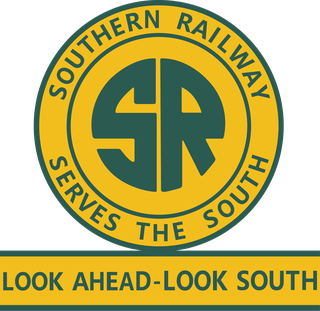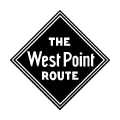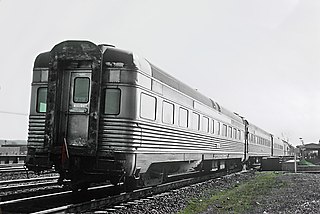Related Research Articles

The Crescent is a daily long-distance passenger train operated by Amtrak in the eastern United States. It operates 1,377 miles (2,216 km) daily between Pennsylvania Station in New York City and Union Passenger Terminal in New Orleans as train numbers 19 and 20. Major service stops outside the Northeast Corridor include Birmingham, Alabama; Atlanta, Georgia and Charlotte, North Carolina.

The Southern Railway is a name of a class 1 railroad that was based in the Southern United States. The railroad is the product of nearly 150 predecessor lines that were combined, reorganized and recombined beginning in the 1830s, formally becoming the Southern Railway in 1894.

The Seaboard Air Line Railroad, which styled itself "The Route of Courteous Service," was an American railroad which existed from April 14, 1900, until July 1, 1967, when it merged with the Atlantic Coast Line Railroad, its longtime rival, to form the Seaboard Coast Line Railroad. Predecessor railroads dated from the 1830s and reorganized extensively to rebuild after the American Civil War. The company was headquartered in Norfolk, Virginia, until 1958, when its main offices were relocated to Richmond, Virginia. The Seaboard Air Line Railway Building in Norfolk's historic Freemason District still stands and has been converted into apartments.

The Richmond, Fredericksburg, and Potomac Railroad was a railroad connecting Richmond, Virginia, to Washington, D.C. The track is now the RF&P Subdivision of the CSX Transportation system; the original corporation is no longer a railroad company.

The Richmond and Danville Railroad (R&D) Company was a railroad that operated independently from 1847 until 1894, first in the U.S. state of Virginia and later on 3,300 miles (5,300 km) of track in nine states.
Algernon Sidney Buford of Chatham, Virginia, is best known for his presidency of the Richmond and Danville Railroad during its massive post civil war expansion into the Southern Railway system.

The Atlanta and West Point Rail Road was a railroad in the U.S. state of Georgia, forming the east portion of the Atlanta-Selma West Point Route. The company was chartered in 1847 as the Atlanta and LaGrange Rail Road and renamed in 1857; construction of the 5 ft gauge line was begun in 1849-50 and completed in May 1854. A large minority interest owned by the Georgia Railroad and Banking Company eventually passed under the control of the Atlantic Coast Line Railroad (ACL), which later acquired a majority of the stock.
The Michigan Air Line Railroad was a planned railroad across southern Michigan, connecting the Canada Southern Railway to Chicago, Illinois. Only part of the line was built, and it was split between the Michigan Central Railroad and the Grand Trunk Railway.

An air-line railroad was a railroad that was relatively flat and straight, choosing a shorter route over an easier route. In their heyday, which was prior to aviation, they were often referred to simply as "air lines". For example, a 1903 novel indicates a character's success by noting his position as "superintendent of passenger traffic of the New York and Chicago Air Line", a fictitious railroad.

The Pittsburgh, Cincinnati, Chicago and St. Louis Railroad, commonly called the Pan Handle Route, was a railroad that was part of the Pennsylvania Railroad system. Its common name came from its main line, which began at Pittsburgh, Pennsylvania, crossed the Northern Panhandle of West Virginia, and continued west to Bradford, Ohio, where it split into a northern line to Chicago and a southern one through Indianapolis, Indiana, to East St. Louis, Illinois.

Richmond Locomotive Works was a steam locomotive manufacturing firm located in Richmond, Virginia.

The Atlanta, Birmingham and Coast Railroad was organized in 1926 to replace the Atlanta, Birmingham and Atlantic Railway. The AB&C was controlled by the Atlantic Coast Line Railroad, which owned a majority of the stock. In 1944 it reported 763 million net ton-miles of revenue freight and 33 million passenger-miles; at the end of that year it operated 639 miles of road and 836 miles of track.
The Richmond and York River Railroad Company was incorporated under an act of the Virginia General Assembly on January 31, 1853. The State of Virginia subscribed to 60 per cent of the capital stock. The company built and initially operated 39 miles (63 km) of railroad line between Richmond, Virginia and West Point, Virginia on the York River. The railroad prospered during the first year of the American Civil War but was wrecked during the Peninsula Campaign. It was rebuilt after the Civil War. In 1894, it became part of the Southern Railway Company.

The Silver Comet was a streamlined passenger train inaugurated on May 18, 1947, by the Seaboard Air Line Railroad. Before its inaugural run, the new train was christened by actress Jean Parker at Pennsylvania Station in New York City.
The Carolina & Northwestern Railway (Ca&NW) was a railroad that served South Carolina and North Carolina from 1897 until January 1, 1974. The original line was operated by the Ca&NW as a separate railroad controlled by the Southern Railway until 1974 when the name was changed to the Norfolk Southern Railway. On June 1, 1982, Southern Railway and Norfolk and Western Railroad merged to form Norfolk Southern Railway. Choosing to use the name 'Norfolk Southern Railway' for the merger, in 1981, the original Ca&NW line along with original Norfolk Southern Railway was renamed Carolina and Northwestern once again. In the early 1950s several shortline subsidiaries of the Southern Railway were leased to the Ca&NW for operation, with these lines remaining a part of the Ca&NW into the 1980s.
References
- "Atlanta & Richmond Air-Line Railway". Railga.com.
| This United States rail–related article is a stub. You can help Wikipedia by expanding it. |